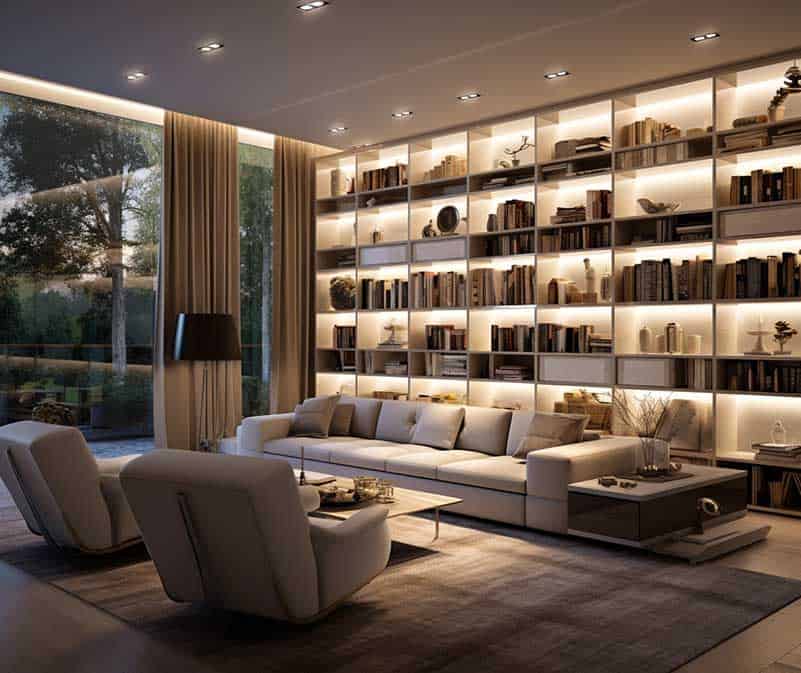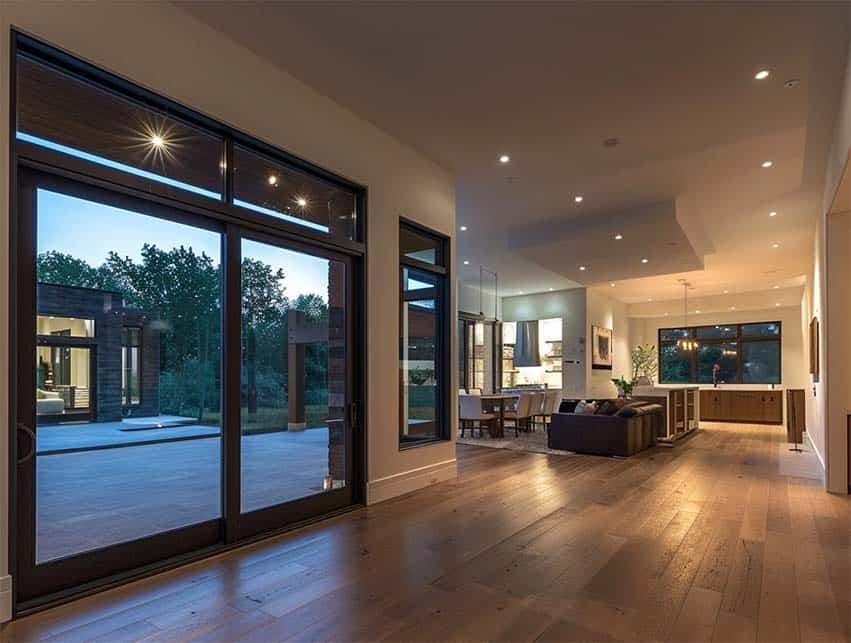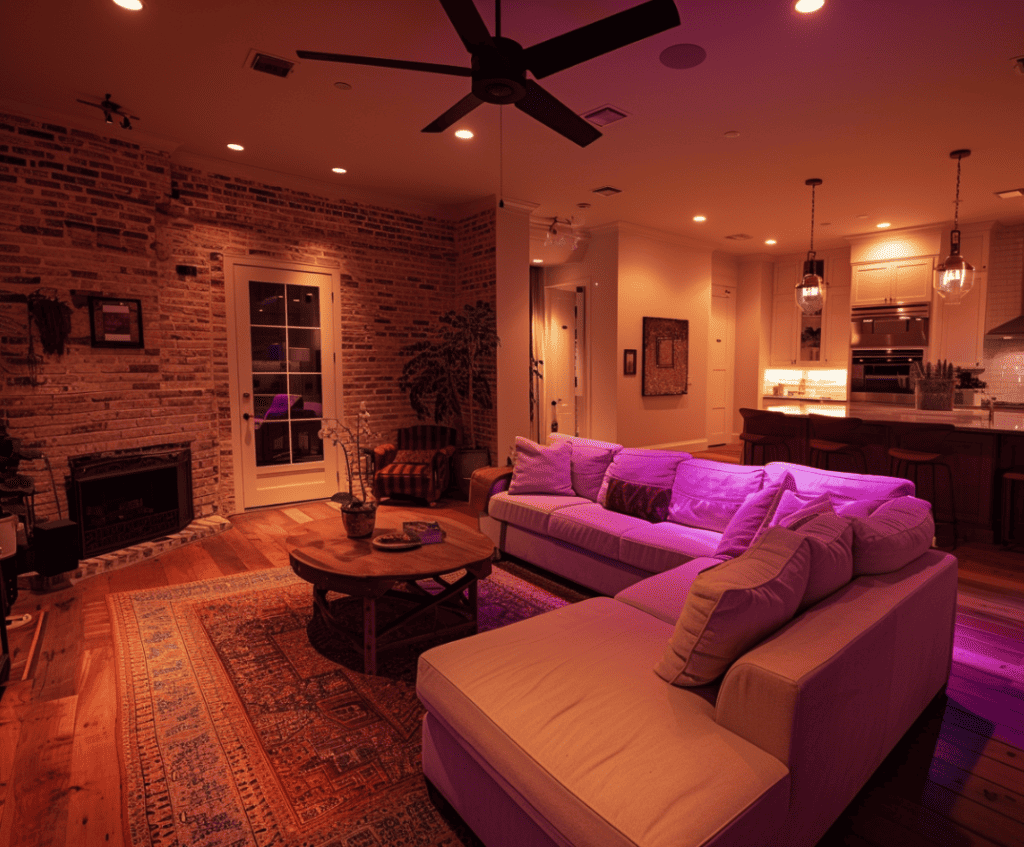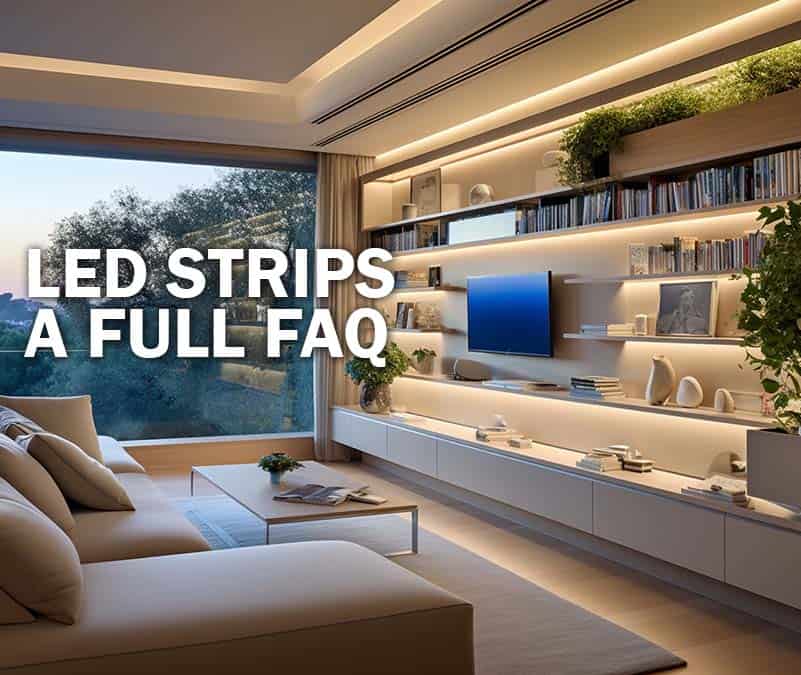LED LIGHTING – FAQ

Why an FAQ on LED lighting?
Since LED lighting has changed for the better the way people light up their homes, San Antonio licensed electrician All Star Electric has been asked dozens of questions by homeowners thinking of switching their lighting system from incandescent to LED. It seemed appropriate for us to make a list of the questions most often asked and publish our answers on our site.
We will expand this FAQ as we receive new questions and face new scenarios, as LED technology is changing continually. If you came to find answers you have not received in this list, please let us know using our Contact form. We will be glad to do our best to provide you with simple and accurate answers.
What is the main disadvantage of LED lighting in an office?
The main disadvantage of LED lighting in an office is that it can cause glare and discomfort due to its high brightness, especially if not properly diffused or directed. A professional electrician will advise clients as to best practices in this regard when installing an LED lighting system.
What is the main disadvantage of LED lighting in a home?
In a home setting, the main disadvantage of LED lighting is the upfront cost, higher than traditional lighting options (incandescent bulb or small fluorescent tubes). Additionally, the quality of light can vary greatly between different LED products. A good professional electrician will select the best LED products for the client’s budget.
What is the main disadvantage of LED lighting in a factory or workshop?
In a factory or workshop, the main disadvantage of LED lighting is that being directional, it can’t provide the same level of brightness as traditional high-intensity discharge (HID) lamps, potentially affecting visibility in large, open spaces. A qualified electrician, especially electrical engineering firms, will calculate the number of LED light banks with luminance studies during the preparation phase of a lighting system replacement project.
What are the advantages and disadvantages of LED light?
Advantages of LED light include energy efficiency, long lifespan, and a wide range of color options. Disadvantages include higher upfront cost, potential for poor color rendering, and sensitivity to temperature. A professional electrician will know what product to select for reliability, and how to install the new LED lighting system to ensure sufficient ventilation to avoid overheating.
What are the disadvantages of LED light strips?
The main disadvantages of LED light strips include potential for uneven light distribution, adhesive failure leading to falling strips, and the need for a power source (a transformer), which can limit placement options. In a home remodeling context, a professional electrician will measure the luminance of the rooms where the homeowners want to install an LED lighting system, so as to advice clients as to the number of LED strips they need to accomplish their purpose.
What are the benefits of LED lights?
Benefits of LED lights include energy efficiency, long lifespan, reduced heat output, and the ability to produce a wide range of colors and light intensities. Professional electricians working on a home remodeling project will offer the homeowners a comparison between a traditional lighting system and LED lights, and estimate the energy cost savings before recommending a solution.
What are common failures of LED lighting?
Common failures of LED lighting include premature dimming, flickering, color shift, and complete failure, often due to issues with the LED driver or heat management. A professional electrician knows what LED products offer the best reliability and stability, and how to install these products to ensure sufficient ventilation and avoid system failures.
Are LED lights good or bad for eyes?
LED lights are generally safe for eyes, but exposure to high-intensity, blue-rich LED light can cause eye strain and discomfort. It’s important to choose LEDs with a warm color temperature and appropriate brightness for the setting. A good electrician knows enough about LED product options to recommend a product that is adapted to the specific situation, whether a home, an office, a photo studio, a retail store, or a car repair shop.
How long do LED lights last?
LED lights can last up to 50,000 hours or more, depending on the quality of the light and the conditions of use. This is significantly longer than traditional incandescent or fluorescent bulbs which makes LED lighting a “greener” option.
What are the disadvantages of LED screens compared to LCD screens?
The main disadvantages of LED screens compared to LCD screens include a higher cost, potential for burn-in with static images, and sometimes less accurate color reproduction. OLED technology has drastically improved color rendition of phone screens and decreased the risk of burn-in.
Do LEDs use less electricity and how much?
Yes, LEDs use less electricity than traditional incandescent or fluorescent bulbs. Depending on the specific LED and traditional bulb being compared, LEDs can use up to 80% less energy. Retail packaging of LED bulbs mention the differences in watts/hour between the different types of bulbs. A professional electrician will be able to give clients an estimate of the annual cost savings they can expect when switching from traditional lighting to LED lighting.
Do LED strip lights raise electric bill vs. incandescent bulbs?
While LED strip lights do use electricity, they are more energy-efficient than incandescent bulbs and are unlikely to significantly raise your electric bill. In fact, they will lower your electric bill in most cases.
Do LED strips waste a lot of electricity?
LED strips do not waste a lot of electricity. They are among the most energy-efficient lighting options available. This is because LEDs transform most of the electric current into light, instead of wasting it in the form of heat. This said, a professional electrician will take into account the potential for overheating of an LED lighting system and take the proper measures when installing it.
Can LED lights cause headaches?
LED lights can potentially cause headaches if they are flickering at a high frequency, or if the light is too bright or has a high proportion of blue light. All such concerns are resolved by proper calibration and luminance calculations done with the professional electrician before installation.
Why does LED light damage the eyes?
High-intensity, blue-rich LED light can potentially damage the eyes over time by causing strain and discomfort, and potentially contributing to macular degeneration. This is why phone manufacturers offer a blue light filter setting in the software installed on their phones.
Do LED lights attract bugs?
LED lights do not typically attract bugs as much as incandescent lights do. This is because LEDs emit less heat and can be designed to emit light in specific wavelengths that are less attractive to bugs. This said, there are LED-based lights that are specifically designed to attract flies and other flying insects in a home.
What is a healthy alternative to LED lights?
Natural sunlight is the healthiest alternative to LED lights. If natural light isn’t available, incandescent bulbs, halogen bulbs, or LEDs with a warm color temperature and high color rendering index (CRI) can be used. Ask your electrical contractor for advice.
What is the most harmful light for eyes?
The most harmful light for eyes is ultraviolet (UV) light, which can cause damage to the cornea and retina. Blue light, especially from digital screens and high-intensity LEDs, can also cause eye strain and potential long-term damage. Ask your professional electrician for advice when installing a lighting system in your home, your office or your store.
Is it OK to leave my LED lights on all night?
It’s generally safe to leave LED lights on all night, as they don’t generate much heat. However, it’s best to turn off unnecessary lights to save energy and create a better sleep environment. Ask your professional electrician if they can install a timer solution to turn off lights automatically.
Should I leave my LED lights on all day?
Probably not. While LED lights can be left on all day without overheating, it’s more energy-efficient to turn them off when not needed. As professional electricians, we don’t recommend wasting energy.
Is it safe to leave LED lights on all day?
Yes, it is safe to leave LED lights on all day. They don’t generate much heat, which makes them safe to leave on for extended periods. However, as professional electricians, we advise clients to install sensors and timers that will turn LED lights off automatically when not in use.
Do LED lights attract spiders?
LED lights do not specifically attract spiders. However, any light can attract insects, which in turn can attract spiders. Some household lights are specifically made to attract and trap insects.
Do LEDs get hot?
LEDs produce some heat, but much less than traditional incandescent bulbs. The heat generated is pulled away by a heat sink in the base of the bulb. This is the case for instance of LED light bulbs for cars and motorcycles.
How much does it cost to run a LED light bulb for 24 hours?
The cost depends on the wattage of the LED bulb and the cost of electricity in your area. For example, a 10-watt LED bulb used for 24 hours would use 0.24 kilowatt-hours. If electricity costs 10 cents per kilowatt-hour, it would cost about 2.4 cents to run the bulb for 24 hours.
Do LED lights cause cataracts?
As far as we know, there is no conclusive evidence that LED lights cause cataracts. However, excessive exposure to intense light, including blue light from LEDs, can contribute to eye strain and discomfort, and potentially to macular degeneration. This is why some phone manufacturers have started to embed a blue light filter in the software commanding their devices.
What is the best light for your eyes?
The best light for your eyes is natural light. When using artificial light, it’s best to use warm, diffused light that mimics natural light as closely as possible. Ask a professional electrician for guidance.
Do LED lights cause anxiety?
To our knowledge, there is no direct evidence that LED lights cause anxiety. However, exposure to high-intensity, blue-rich light can interfere with sleep patterns, which could potentially affect mood and anxiety levels. We also read a research study indicating that sleep patterns can be interrupted by varying light intensity during the day, with some potential consequences on people’s health.
Why do LEDs make me feel sick?
Some people may feel sick from LED lights due to flicker sensitivity or overexposure to high-intensity, blue-rich light, which can cause eye strain and headaches. Ask a licensed electrician how to reduce these issues.
Do LED lights cause mental health issues?
To our knowledge, there’s no direct evidence that LED lights cause mental health issues. However, exposure to high-intensity, blue-rich light can interfere with sleep patterns, which could potentially affect mood and mental health. Ask your doctor about it.
Does LED light affect your brain?
LED lights can affect your brain indirectly by influencing your circadian rhythm. Exposure to blue light from LEDs in the evening can suppress the production of melatonin, a hormone that helps regulate sleep, potentially leading to sleep disturbances. Ask your doctor about it.
Do LED lights cause macular degeneration?
There’s some evidence suggesting that overexposure to blue light, which is emitted by LEDs and other digital screens, could contribute to macular degeneration over time. However, the consensus is that more research is needed to fully understand the link. Some mobile phone manufacturers offer a blue-light setting on their devices to moderate that risk.
How do I protect myself from LED lights?
To protect yourself from LED lights, choose LEDs with a warm color temperature, use a dimmer if possible, and avoid looking directly at the light source. You can also use screen filters or wear glasses with blue light filtering lenses when using your computer and other digital devices.
Why do LED lights mess with my eyes?
LED lights can mess with your eyes if they emit a high proportion of blue light or if they flicker at a high frequency. Overexposure to high-intensity, blue-rich light can cause eye strain, discomfort, and according to research, potentially contribute to long-term eye issues.
What is LED lighting and how does it work?
LEDs (Light Emitting Diodes) are semiconductor devices. When electrical current flows through, they emit light. Unlike traditional bulbs, LEDs produce light through electroluminescence, a process where electrons release energy as photons, resulting in visible light without significant heat.
How are LED lights different from traditional incandescent bulbs?
LEDs differ fundamentally in their operation. While incandescent bulbs produce light by heating a filament, LEDs use electroluminescence. This makes LEDs more energy-efficient, longer-lasting, and cooler. They also offer better luminous efficacy and diverse color temperature options.
What are the benefits of using LED lights in my home?
LEDs offer homeowners numerous advantages. They consume less energy, reducing electricity bills. Their longer lifespan means fewer replacements. They emit minimal UV radiation, protecting interiors. With diverse color temperatures, homeowners can customize ambiance. Additionally, they integrate well with smart home systems.
How long do LED lights typically last?
Quality LEDs can last between 25,000 to 50,000 hours, or even longer. This translates to 15-20 years with average home usage. Their longevity is attributed to efficient energy conversion, producing minimal heat, reducing wear and tear.
How do I install LED lights in my home?
For bulb replacements, it’s often a direct swap. For fixtures, turn off electricity, remove the old fixture, and install the LED one following manufacturer guidelines. Complex systems, like integrated LED setups, might require professional installation to ensure safety and optimal performance.
Can I replace my existing light bulbs with LED bulbs?
Absolutely. Modern LED bulbs are designed to fit traditional sockets. When replacing, ensure the LED’s base type matches the socket and that its luminosity (measured in lumens) suits your needs. Also, consider color temperature for desired ambiance.
Are there specific types of LED lights for different areas of my home?
Yes. LEDs come in various forms: spotlights for focused lighting, strip lights for decorative purposes, and standard bulbs for general lighting. There are also specialized LEDs for wet locations like bathrooms and outdoors.
How do I choose the right LED light color for my space?
LEDs offer a range of color temperatures, measured in Kelvins (K). Warm light (2,000-3,000K) provides a cozy ambiance, while cool white (3,500-4,100K) is energizing. Daylight tones (5,000-6,500K) mimic natural sunlight. Choose based on room function and desired mood.
How energy-efficient are LED lights compared to other lighting options?
LEDs are highly energy-efficient, consuming up to 75% less energy than incandescents. Their luminous efficacy, the lumens produced per watt of energy, is superior. This efficiency translates to lower electricity bills and reduced carbon footprint, making them environmentally favorable.
Can I save on my electricity bill by switching to LED lighting?
Definitely. LEDs consume significantly less power than traditional bulbs. By replacing incandescents with LEDs, homeowners can see electricity bill reductions of up to 80%. Over time, the savings can offset the initial cost of LED bulbs.
Are there any energy rebates or incentives for using LED lights in San Antonio, TX?
San Antonio often promotes energy efficiency. Homeowners might find rebates or incentives for LED installations through local utility providers or city programs. It’s advisable to check with local authorities or utility companies for current offers.
Are LED lights safer than traditional bulbs?
Yes, LEDs are safer. They produce minimal heat, reducing burn and fire risks. Unlike some fluorescents, they don’t contain hazardous substances like mercury. Their sturdy design, often without fragile glass components, also minimizes breakage risks.
Do LED lights emit UV radiation?
LEDs emit negligible UV radiation, much less than other light sources. This minimal emission protects fabrics and artworks from fading and is safer for skin exposure, making them ideal for residential interiors.
Are there local regulations in San Antonio regarding LED lighting installation?
San Antonio has building codes and electrical regulations that cover lighting installations. LED installations generally follow standard electrical guidelines. We advise homeowners to hire a licensed electrician to ensure compliance and safety.
What are the different types of LED lights available in the market?
The LED market offers diverse options: standard bulbs, spotlights, floodlights, strip lights, and panel lights. There are also specialized LEDs for specific applications like horticultural growth, aquariums, and photography, catering to various needs and preferences.
Can I use LED lights for outdoor lighting?
Certainly. There are outdoor-specific LEDs designed to withstand environmental factors like rain and temperature fluctuations. They’re ideal for landscaping, patios, and security lighting, offering durability and efficient performance.
Are there dimmable LED lights?
Many LEDs are dimmable, allowing homeowners to adjust brightness. However, it’s essential to pair them with compatible dimmer switches to prevent flickering and ensure smooth dimming.
How do I choose between warm white, cool white, and daylight LED bulbs?
Warm white creates a cozy, welcoming ambiance, ideal for living rooms. Cool white is brighter, suitable for kitchens and workspaces. Daylight mimics natural light, perfect for reading or art studios. The choice depends on room function and personal preference.
How much does it typically cost to install LED lighting in San Antonio?
Installation costs vary based on project scope and fixture type. Simple bulb replacements are cost-effective, while integrated systems might be pricier. It’s best to obtain quotes from local electricians for accurate estimates.
Can I install LED lights myself or should I hire a professional?
Simple bulb replacements are DIY-friendly. However, for installations involving wiring or complex fixtures, hiring a professional ensures safety and adherence to local regulations.
How do I choose a reliable LED lighting contractor in San Antonio?
Research online reviews, verify licenses, and seek recommendations. Organizations like the Better Business Bureau can provide insights. Ensure the contractor has experience with LED installations for best results.
What is the difference between LED and OLED?
LEDs use inorganic materials to emit light, while OLEDs (Organic Light Emitting Diodes) use organic compounds. OLEDs can produce deeper blacks and are often used in displays, while LEDs are more common for general lighting due to their efficiency and longevity.
Can LED lights be used with smart home systems?
Yes. Many modern LEDs integrate with smart home systems, allowing remote control, dimming, color changing, and scheduling. They can work with platforms like Alexa, Google Home, and Apple HomeKit for enhanced home automation.
Are there any advanced LED lighting technologies or features I should be aware of?
Emerging LED technologies include Li-Fi, where LEDs transmit data, and human-centric lighting, adjusting light for well-being. Innovations like color-tunable LEDs and integrated sensors are also gaining traction, enhancing user experience.
How do LED lights impact the environment compared to other lighting options?
LEDs are environmentally favorable due to their energy efficiency, reducing carbon emissions. They lack harmful chemicals like mercury. However, their recycling infrastructure isn’t as established as for incandescent bulbs, presenting some environmental challenges.
Additional Resources
Blog posts:
8 LED Lighting systems
Using LEDs to remodel a store
Many answers on LED light strips, installation, replacement, safe handling
Website: Kichler has a most interesting assortment of LED fixtures




























